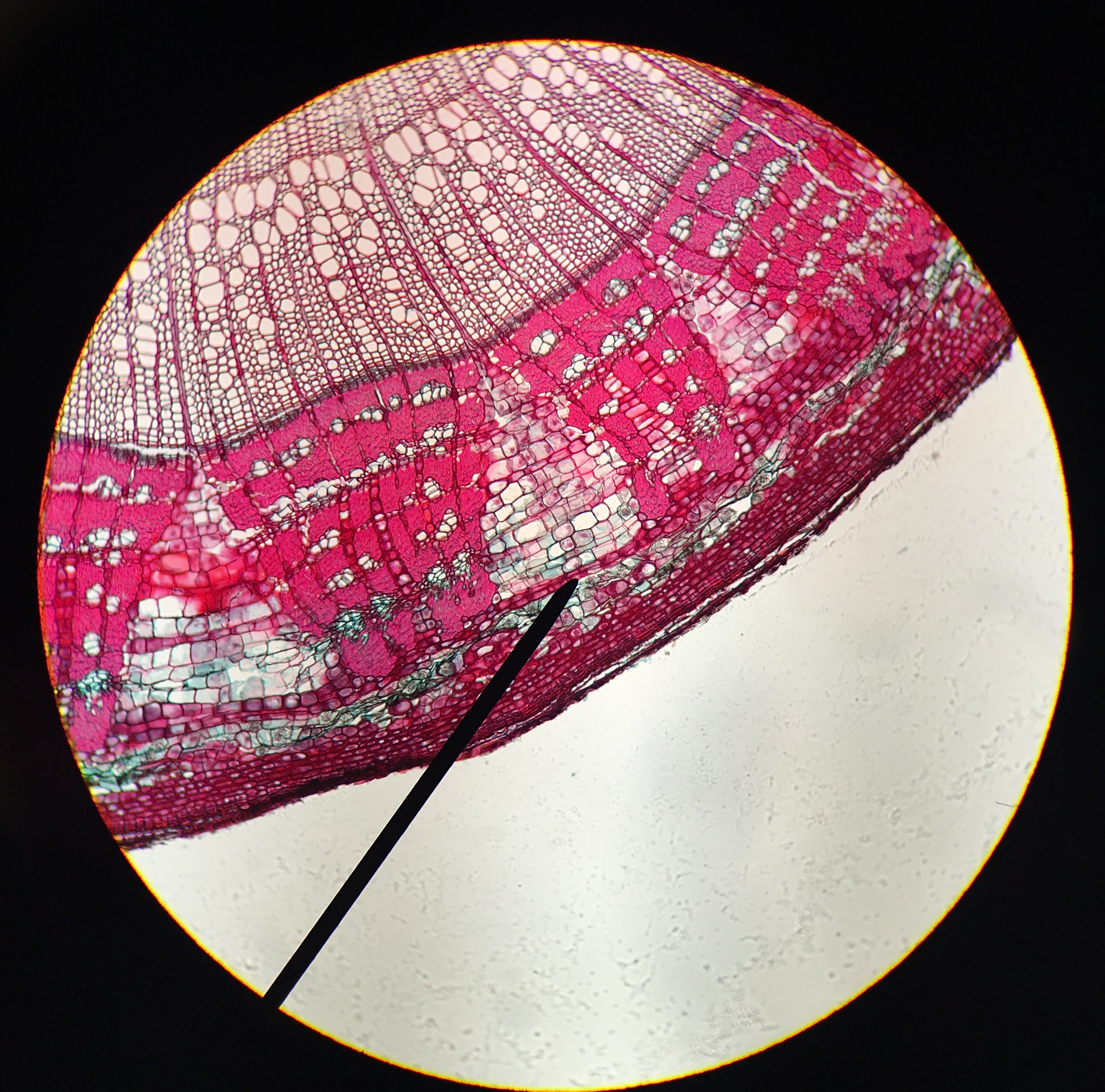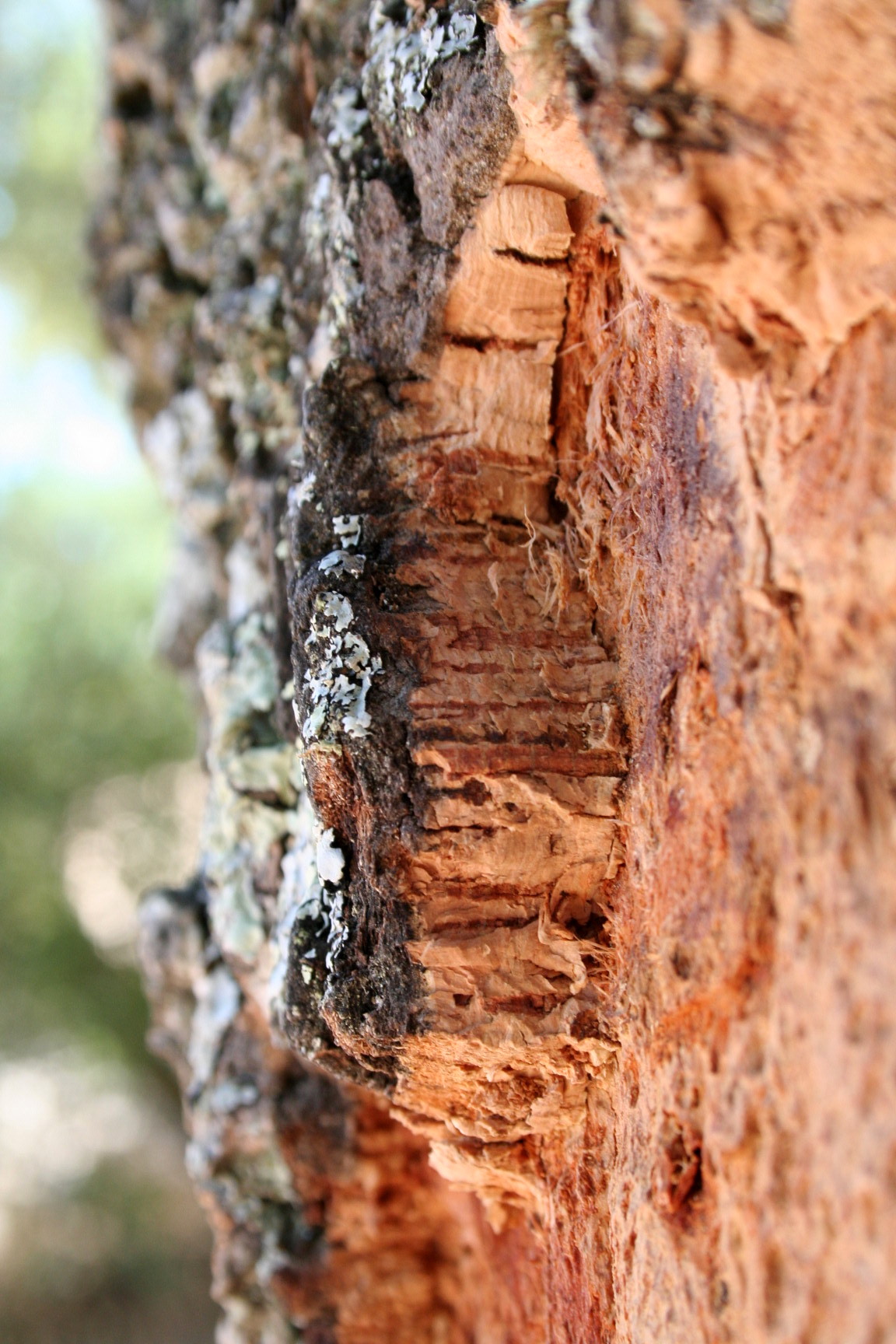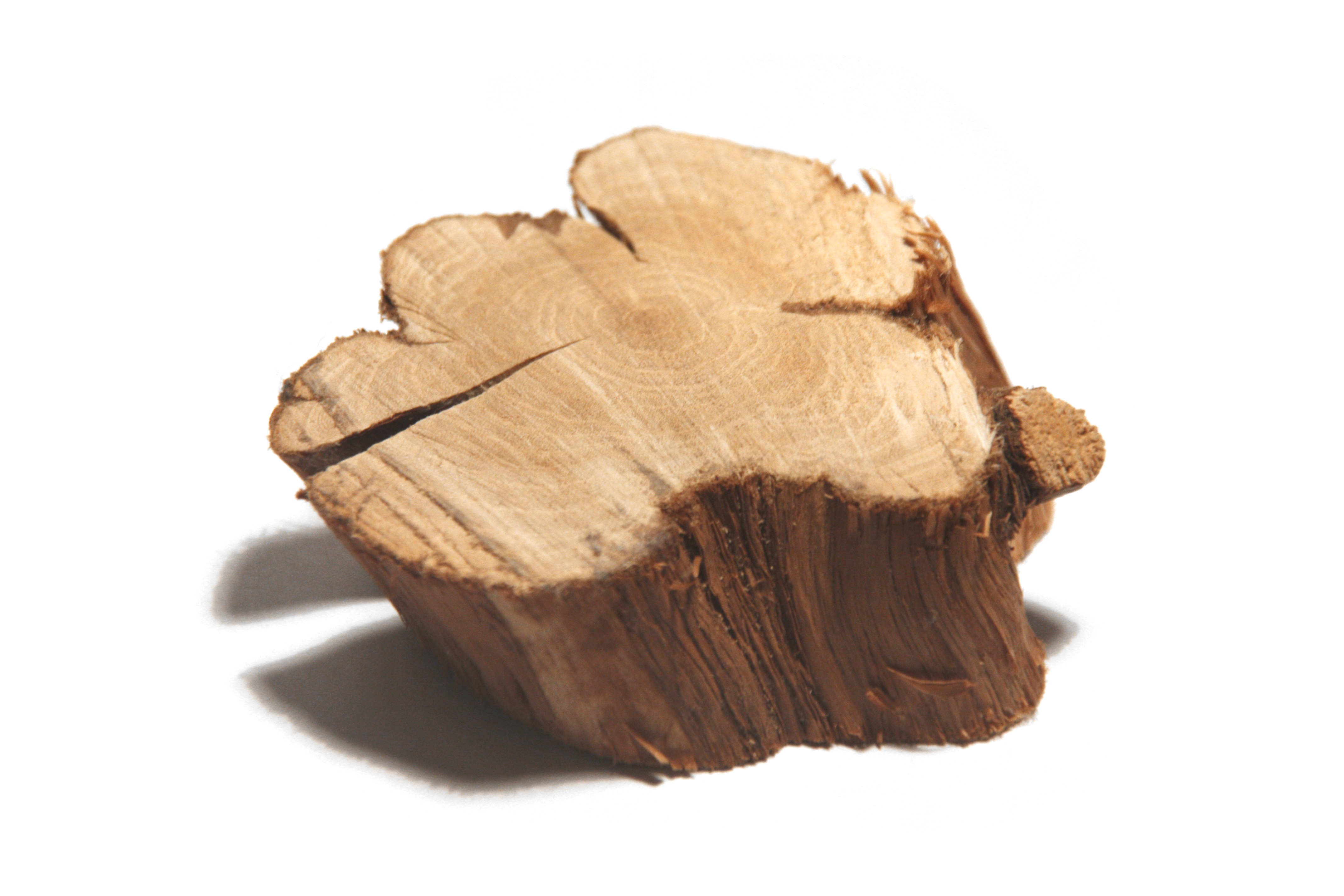|
Cambial
A cambium (: cambiums or cambia), in plants, is a tissue layer that provides partially undifferentiated cells for plant growth. It is found in the area between xylem and phloem. A cambium can also be defined as a cellular plant tissue from which phloem, xylem, or cork grows by division, resulting (in woody plants) in secondary thickening. It forms parallel rows of cells, which result in secondary tissues. There are several distinct kinds of cambium found in plant stems and roots: * Cork cambium, a tissue found in many vascular plants as part of the periderm. * Unifacial cambium, which ultimately produces cells to the interior of its cylinder. * Vascular cambium, a lateral meristem in the vascular tissue of plants. Uses The cambium of many species of woody plants are edible; however, due to its vital role in the homeostasis and growth of woody plants, this may result in death of the plant if enough cambium is removed at once. The cambium can generally be eaten raw or cooked, ... [...More Info...] [...Related Items...] OR: [Wikipedia] [Google] [Baidu] |
Vascular Cambium
The vascular cambium is the main growth tissue in the stems and roots of many plants exhibiting secondary growth, specifically in dicots such as buttercups and oak trees, gymnosperms such as pine trees, as well as in certain other vascular plants. It produces secondary xylem inwards, towards the pith, and secondary phloem outwards, towards the bark. Generally, more secondary xylem is produced than secondary phloem. In herbaceous plants, it occurs in the vascular bundles which are often arranged like beads on a necklace forming an interrupted ring inside the stem. In woody plants, it forms a cylinder of unspecialized meristem cells, as a continuous ring from which the new tissues are grown. Unlike the xylem and phloem, it does not transport water, minerals or food through the plant. Other names for the vascular cambium are the main cambium, wood cambium, or bifacial cambium. Occurrence Vascular cambia are found in all seed plants except for five angiosperm lineages whi ... [...More Info...] [...Related Items...] OR: [Wikipedia] [Google] [Baidu] |
Meristem
In cell biology, the meristem is a structure composed of specialized tissue found in plants, consisting of stem cells, known as meristematic cells, which are undifferentiated cells capable of continuous cellular division. These meristematic cells play a fundamental role in plant growth, regeneration, and acclimatization, as they serve as the source of all differentiated plant tissues and organs. They contribute to the formation of structures such as fruits, leaves, and seeds, as well as supportive tissues like stems and roots. Meristematic cells are totipotent, meaning they have the ability to differentiate into any plant cell type. As they divide, they generate new cells, some of which remain meristematic cells while others differentiate into specialized cells that typically lose the ability to divide or produce new cell types. Due to their active division and undifferentiated nature, meristematic cells form the foundation for the formation of new plant organs and the c ... [...More Info...] [...Related Items...] OR: [Wikipedia] [Google] [Baidu] |
Cork Cambium 1
"Cork" or "CORK" may refer to: Materials * Cork (material), an impermeable buoyant plant product ** Stopper (plug), or "cork", a cylindrical or conical object used to seal a container ***Wine cork an item to seal or reseal wine Places Ireland * Cork (city) ** Metropolitan Cork, also known as Greater Cork ** Cork Airport * County Cork Historical parliamentary constituencies * Cork City (Parliament of Ireland constituency) * County Cork (Parliament of Ireland constituency) * Cork City (UK Parliament constituency) * County Cork (UK Parliament constituency) United States * Cork, Georgia * Cork, Kentucky Organisations * Cork GAA, responsible for Gaelic games in County Cork * Ye Antient Order of Noble Corks, a masonic order, also known as "The Cork" * Cork City F.C., a football club * Cork City W.F.C., a women's football club Other uses * A particular kind of trick in snowboarding and skiing. * Cork (surname) * Cork City (barony) * Cork encoding, a digital data format * Cork taint ... [...More Info...] [...Related Items...] OR: [Wikipedia] [Google] [Baidu] |
Plant Cell
Plant cells are the cells present in Viridiplantae, green plants, photosynthetic eukaryotes of the kingdom Plantae. Their distinctive features include primary cell walls containing cellulose, hemicelluloses and pectin, the presence of plastids with the capability to perform photosynthesis and store starch, a large vacuole that regulates turgor pressure, the absence of Flagellum, flagella or centrioles, except in the gametes, and a unique method of cell division involving the formation of a cell plate or phragmoplast that separates the new daughter cells. Characteristics of plant cells * Plant cells have cell walls composed of cellulose, hemicelluloses, and pectin and constructed outside the cell membrane. Their composition contrasts with the cell walls of fungus, fungi, which are made of chitin, of bacteria, which are made of peptidoglycan and of archaea, which are made of pseudopeptidoglycan. In many cases lignin or suberin are secreted by the protoplast as secondary wall laye ... [...More Info...] [...Related Items...] OR: [Wikipedia] [Google] [Baidu] |
Xylem
Xylem is one of the two types of transport tissue (biology), tissue in vascular plants, the other being phloem; both of these are part of the vascular bundle. The basic function of the xylem is to transport water upward from the roots to parts of the plants such as stems and leaves, but it also transports plant nutrition, nutrients. The word ''xylem'' is derived from the Ancient Greek word (), meaning "wood"; the best-known wood organism is plants, though it is found throughout a plant. The term was introduced by Carl Nägeli in 1858. Structure The most distinctive xylem cell (biology), cells are the long tracheary elements that transport water. Tracheids and vessel elements are distinguished by their shape; vessel elements are shorter, and are connected together into long tubes that are called ''vessels''. Wood also contains two other type of cells: Ground tissue#Parenchyma, parenchyma and ground tissue#Fibres, fibers. Xylem can be found: * in vascular bundles, present in ... [...More Info...] [...Related Items...] OR: [Wikipedia] [Google] [Baidu] |
Phloem
Phloem (, ) is the living tissue in vascular plants that transports the soluble organic compounds made during photosynthesis and known as ''photosynthates'', in particular the sugar sucrose, to the rest of the plant. This transport process is called translocation. In trees, the phloem is the innermost layer of the bark, hence the name, derived from the Ancient Greek word (''phloiós''), meaning "bark". The term was introduced by Carl Nägeli in 1858. Different types of phloem can be distinguished. The early phloem formed in the growth apices is called protophloem. Protophloem eventually becomes obliterated once it connects to the durable phloem in mature organs, the metaphloem. Further, secondary phloem is formed during the thickening of stem structures. Structure Phloem tissue consists of conducting cells, generally called sieve elements, parenchyma cells, including both specialized companion cells or albuminous cells and unspecialized cells and supportive cells, such ... [...More Info...] [...Related Items...] OR: [Wikipedia] [Google] [Baidu] |
Cork Cambium
Cork cambium (: cambia or cambiums) is a tissue found in many vascular plants as a part of the epidermis. It is one of the many layers of bark, between the cork and primary phloem. The cork cambium is a lateral meristem and is responsible for secondary growth that replaces the epidermis in roots and stems. It is found in woody and many herbaceous dicots, gymnosperms and some monocots (monocots usually lack secondary growth). It is one of the plant's meristems – the series of tissues consisting of embryonic disk (incompletely differentiated) cells from which the plant grows. The function of cork cambium is to produce the cork, a tough protective material.Junikka, L. (1994) "Macroscopic bark terminology". ''IAWA Journal'' 15(1): 3–45Trockenbrodt, M. (1990) "Survey and discussion of the terminology used in bark anatomy". ''IAWA Bulletin, New Series'' 11: 141–166 Synonyms for cork cambium are bark cambium, peri-cambium and phellogen. Phellogen is defined as the meristematic ... [...More Info...] [...Related Items...] OR: [Wikipedia] [Google] [Baidu] |
Periderm
Bark is the outermost layer of stems and roots of woody plants. Plants with bark include trees, woody vines, and shrubs. Bark refers to all the tissues outside the vascular cambium and is a nontechnical term. It overlays the wood and consists of the inner bark and the outer bark. The inner bark, which in older stems is living tissue, includes the innermost layer of the periderm. The outer bark on older stems includes the dead tissue on the surface of the stems, along with parts of the outermost periderm and all the tissues on the outer side of the periderm. The outer bark on trees which lies external to the living periderm is also called the rhytidome. Products derived from bark include bark shingle siding and wall coverings, spices, and other flavorings, tanbark for tannin, resin, latex, medicines, poisons, various hallucinogenic chemicals, and cork. Bark has been used to make cloth, canoes, and ropes and used as a surface for paintings and map making. A number of plants ar ... [...More Info...] [...Related Items...] OR: [Wikipedia] [Google] [Baidu] |
Unifacial Cambium
The unifacial cambium (pl. cambia or cambiums) produces cells to the interior of its cylinder. These cells differentiate into xylem tissue. Unlike the more common bifacial cambium found in later woody plants, the unifacial cambium does not produce phloem to its exterior. Also in contrast to the bifacial cambium, the unifacial cambium is unable to expand its circumference with anticlinal cell division. Cell elongation provides a limited amount of expansion. Unifacial cambium plant morphology and life cycles The unifacial cambium allowed plants to grow as tall as 50 metres. Lacking secondary phloem, unifacial cambium plants developed alternative strategies to long range nutrient transport. For example, the stems of lycophyte The lycophytes, when broadly circumscribed, are a group of vascular plants that include the clubmosses. They are sometimes placed in a division Lycopodiophyta or Lycophyta or in a subdivision Lycopodiophytina. They are one of the oldest lineag ... t ... [...More Info...] [...Related Items...] OR: [Wikipedia] [Google] [Baidu] |
Woody Plant
A woody plant is a plant that produces wood as its structural tissue and thus has a hard stem. In cold climates, woody plants further survive winter or dry season above ground, as opposed to Herbaceous plant, herbaceous plants that die back to the ground until Spring (season), spring. Characteristics Woody plants are usually trees, shrubs, or lianas. These are usually perennial plants whose stems and larger roots are reinforced with wood produced from secondary xylem. The main stem, larger branches, and roots of these plants are usually covered by a layer of Bark (botany), bark. Wood is a structural cell (biology), tissue that allows woody plants to grow from above ground stems year after year, thus making some woody plants the largest and tallest terrestrial plants. Woody plants, like Herbaceous plant, herbaceous perennials, typically have a Dormancy, dormant period of the year when growth does not take place. This occurs in Temperate climate, temperate and Continental clima ... [...More Info...] [...Related Items...] OR: [Wikipedia] [Google] [Baidu] |
Atlas Obscura
''Atlas Obscura'' is an United States, American-based travel and exploration company. It was founded in 2009 by author Joshua Foer and documentary filmmaker/author Dylan Thuras. It catalogs unusual and obscure travel destinations via professional and user-generated content, operates group trips to destinations around the world, produces a daily podcast, as well as books, TV and film. The brand covers a number of topics including history, science, food, and obscure places. History Thuras and Foer met in 2007, and soon discussed ideas for a different kind of atlas, featuring places not commonly found in guidebooks. They hired a web designer in 2008 and launched ''Atlas Obscura'' in 2009. Annetta Black was the site's first senior editor. In 2010, the site organized the first of the international events known as Obscura Day. Thuras has stated that one of the site's main goals is "Creating a real-world community who are engaging with us, each other and these places and getting away ... [...More Info...] [...Related Items...] OR: [Wikipedia] [Google] [Baidu] |
Homeostasis
In biology, homeostasis (British English, British also homoeostasis; ) is the state of steady internal physics, physical and chemistry, chemical conditions maintained by organism, living systems. This is the condition of optimal functioning for the organism and includes many variables, such as body temperature and fluid balance, being kept within certain pre-set limits (homeostatic range). Other variables include the pH of extracellular fluid, the concentrations of sodium, potassium, and calcium ions, as well as the blood sugar level, and these need to be regulated despite changes in the environment, diet, or level of activity. Each of these variables is controlled by one or more regulators or homeostatic mechanisms, which together maintain life. Homeostasis is brought about by a natural resistance to change when already in optimal conditions, and equilibrium is maintained by many regulatory mechanisms; it is thought to be the central motivation for all organic action. All home ... [...More Info...] [...Related Items...] OR: [Wikipedia] [Google] [Baidu] |






